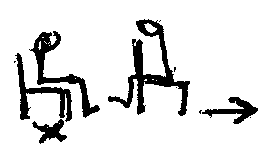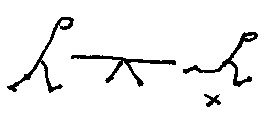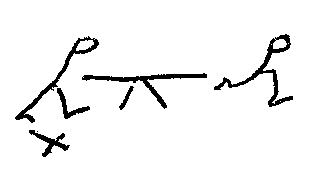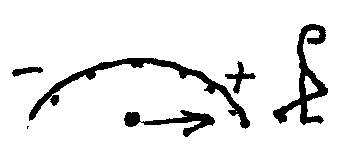Section 49We want to insist that in the order to become familiar with pictography and understand what follows the reader should read first the sections 1 to 43 carefully.
 Real, reality (the real world is made of the things that surround us. The word real comes from Latin and means thing. If we put the circle of generalization (see Section 46.1) well have Reality. Real, reality (the real world is made of the things that surround us. The word real comes from Latin and means thing. If we put the circle of generalization (see Section 46.1) well have Reality.
 Nature is composed of things ( Nature is composed of things ( ) that are not manmade. See the impersonal pronoun It in Section 39. We understand by the word nature all that is not made by humans, like the seas, the stars, the rivers, the stones, the electricity, magnetism, gravity, animals, sexuality, etc. The subject of nature must be It. Nature is an it thing, at least in pictography. But nature has also a more ecological or romantic picto ) that are not manmade. See the impersonal pronoun It in Section 39. We understand by the word nature all that is not made by humans, like the seas, the stars, the rivers, the stones, the electricity, magnetism, gravity, animals, sexuality, etc. The subject of nature must be It. Nature is an it thing, at least in pictography. But nature has also a more ecological or romantic picto 
 Science: The study of nature (somebody at his desk watching nature). Science: The study of nature (somebody at his desk watching nature).
Notice he is watching the analytic picto of nature, not the romantic one.
 Chemistry: A retort, one of those glass containers used in Chemistry, being Chemistry: A retort, one of those glass containers used in Chemistry, being
examine d by someone.
 Chemical reaction: Two things reacting with each other Chemical reaction: Two things reacting with each other
 Reacting substances or reactants: (See the mark x on each of them) Reacting substances or reactants: (See the mark x on each of them)
Process: If we have the picto transformation  (see section 25) and we mark it with the picto (see section 25) and we mark it with the picto  or arrow in between, we are indicating the process of the transformation. As a verb it will mean to proceed: or arrow in between, we are indicating the process of the transformation. As a verb it will mean to proceed:  (the process is marching). See the sign because the picto is in infinitive mood. (the process is marching). See the sign because the picto is in infinitive mood.
 Speed (thing goes slow or fast) Speed (thing goes slow or fast)
 Depending (depending means pending or hanging from something; therefore, a hook) Depending (depending means pending or hanging from something; therefore, a hook)
 Variation (the thing in the first part of the picto has changed its position). But in this case we prefer to say "the speed of the reaction can be faster or Slower (for the comparative, see the Note at the end of this vocabulary) Variation (the thing in the first part of the picto has changed its position). But in this case we prefer to say "the speed of the reaction can be faster or Slower (for the comparative, see the Note at the end of this vocabulary)
 Amount ( graphically Few or Many ) Amount ( graphically Few or Many )
 Simple (by contrast with complicated, see the mark X) Simple (by contrast with complicated, see the mark X)
 Catalyst (Substance pushing ahead a reaction). Remember what we said in section 22 about the compound pictos. Catalyst (Substance pushing ahead a reaction). Remember what we said in section 22 about the compound pictos.
 Rate (movement divided into time) Rate (movement divided into time)
and also (acceleration divided into time): 
 Normally (seating down normally by contrast with seating down as the figure shows, see the mark x) See the arrow underneath towards the main word. Normally (seating down normally by contrast with seating down as the figure shows, see the mark x) See the arrow underneath towards the main word.
Other  Same Same 
He´ll come back on the same day 
Remember the article the is nonexistent in pictography because is always implied before a noun as happens in Russian, Latin, etc unless the context rules it out.
Note: Remember: The pictos we use in pictography show us that the marks (dots and arrows, etc) are important. Nouns have no marks. Verbs bear either the arrow on top or the dot to indicate the tense. So the verbs and even the tenses are identified easily. Adjectives and
adverbs bear the under arrow directed towards the corresponding noun or verb. For Gerund
(**) see section 28.
Faster, Slower: These words are comparatives and we think the scales picto that compares
weights is a good one for this purpose. See the x on the corresponding side.
Faster Slower Slower
Fastest, Slowest: These words mean the maximum or minimum of the velocity. So we take
advantage of the gauge picto to show the maximum and minimum of velocity or whatever
magnitude we are referring to. See the direction of the pointer.
Fastest Slowest Slowest
More pictograms:
To accelerate To slow down To slow down 
Acceleration Slowing down (noun) Slowing down (noun)
Fast Slow Slow Slowly Slowly
He is slowing down 
He eats now less than before 
|

 Real, reality (the real world is made of the things that surround us. The word real comes from Latin and means thing. If we put the circle of generalization (see Section 46.1) well have Reality.
Real, reality (the real world is made of the things that surround us. The word real comes from Latin and means thing. If we put the circle of generalization (see Section 46.1) well have Reality. Normally (seating down normally by contrast with seating down as the figure shows, see the mark x) See the arrow underneath towards the main word.
Normally (seating down normally by contrast with seating down as the figure shows, see the mark x) See the arrow underneath towards the main word.

 Slow
Slow Slowly
Slowly